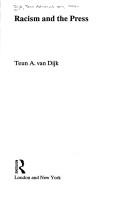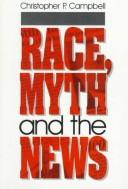| Listing 1 - 10 of 16 | << page >> |
Sort by
|
Book
ISBN: 9780415676397 9780415676403 9780203146309 Year: 2012 Publisher: New York, NY : Routledge,
Abstract | Keywords | Export | Availability | Bookmark
 Loading...
Loading...Choose an application
- Reference Manager
- EndNote
- RefWorks (Direct export to RefWorks)
Sports journalism --- Racism in the press --- Minorities --- Press coverage
Dissertation
ISBN: 9188212181 Year: 2004 Publisher: Göteborg Göteborgs universitet. Institutionen för journalistik och masskommunikation
Abstract | Keywords | Export | Availability | Bookmark
 Loading...
Loading...Choose an application
- Reference Manager
- EndNote
- RefWorks (Direct export to RefWorks)
Immigrants --- Racism in the press --- Racism --- Refugees --- Press coverage
Book
ISBN: 0252053044 9780252053047 9780252044106 025204410X 9780252086151 0252086155 Year: 2021 Publisher: Urbana
Abstract | Keywords | Export | Availability | Bookmark
 Loading...
Loading...Choose an application
- Reference Manager
- EndNote
- RefWorks (Direct export to RefWorks)
White publishers and editors used their newspapers to build, nurture, and protect white supremacy across the South in the decades after the Civil War. At the same time, a vibrant Black press fought to disrupt these efforts and force the United States to live up to its democratic ideals. 'Journalism and Jim Crow' centres the press as a crucial political actor shaping the rise of the Jim Crow South. The contributors explore the leading role of the white press in constructing an anti-democratic society by promoting and supporting not only lynching and convict labour but also coordinated campaigns of violence and fraud that disenfranchised Black voters.
Journalism --- American newspapers --- African American newspapers --- Racism in the press --- History --- Political aspects
Book
ISBN: 9782753596900 Year: 2024 Publisher: Rennes : Presses universitaires de Rennes,
Abstract | Keywords | Export | Availability | Bookmark
 Loading...
Loading...Choose an application
- Reference Manager
- EndNote
- RefWorks (Direct export to RefWorks)
"Germain Ibron dit « Germain le Nègre », « Battling Youyou », Abdelkader Abbès, Panama Al Brown, Battling Siki, René Menrath, Tommy Bakou, Henri Soya, Boughéra El Ouafi, Jack Johnson alias Le Géant de Gavelston, Ali Neffati, Paul Hams, Bob-le-Noir... Ces noms et surnoms révèlent l'existence d'un vivier de boxeurs, de cyclistes, de lutteurs, de rugbymen dits de couleur dans la France des années 1860-1930. Ils sont alors connus et appréciés par les amateurs de sport. Mais ils n'ont pas marqué la mémoire collective. Parce qu'ils n'étaient pas blancs ? Ce livre tranche cette question en étudiant la construction médiatique de l'altérité à partir de l'analyse de plus de 20 000 articles dans la presse de l'époque. Il montre la polyphonie des discours sur ces sportifs et l'ambivalence de leurs représentations. Rien n'est réductible à une certaine doxa historiographique et journalistique affirmant que les sportifs issus des colonies ou de l'immigration ultramarine et afro-américaine ont été victimes, sans exception, d'un syndrome raciste, rejetés, lynchés par la presse. L'accueil qu'on leur a fait est bien plus nuancé : si la dimension « raciale » demeure, ce que nul ne peut nier, elle tend souvent à passer au second plan. Dans certains cas, elle s'efface même et cohabite avec une admiration non feinte rebattant les cartes de notre perception de ces champions d'un autre temps. Une histoire complexe en somme, faisant revivre ces figures oubliées en évitant l'ornière de la caricature et des petites mythologies." (éditeur)
Racism in sports --- Athletes, Black --- Racism in the press --- Press coverage --- History.
Book
ISBN: 158838408X 9781588384089 9781588384072 Year: 2020 Publisher: Montgomery
Abstract | Keywords | Export | Availability | Bookmark
 Loading...
Loading...Choose an application
- Reference Manager
- EndNote
- RefWorks (Direct export to RefWorks)
"Coming Full Circle is a self-reflective exploration of the author's life journey from growing up in coastal Savannah, Georgia, to editing roles at seven daily newspapers around the country, and circling back to her retirement in Savannah, where she now teaches journalism to a new generation." --Publisher.
African American newspaper editors --- African American women journalists --- Journalists --- African Americans --- Racism in the press. --- Civil rights. --- Lloyd, Wanda S.

ISBN: 0802084575 144267394X 9781442673946 0802036007 9780802036001 9780802084576 0802086152 Year: 2002 Publisher: Toronto, Ont. University of Toronto Press
Abstract | Keywords | Export | Availability | Bookmark
 Loading...
Loading...Choose an application
- Reference Manager
- EndNote
- RefWorks (Direct export to RefWorks)
"Discourses of Domination explores the issue of racial bias in the Canadian English-language press. Applying critical discourse analysis as their principal methodology, Frances Henry and Carol Tator investigate the way in which the media produce, reproduce, and disseminate racist thinking through language and discourse." "The core of the text consists of a series of case studies, including several high-profile cases involving the alleged criminality of persons of colour. Using these case studies as a springboard, Henry and Tator demonstrate how the media construct people of colour, immigrants, refugees, and First Nations peoples as 'others' - those who live outside the 'imagined community' of Canada. Their analysis ultimately points to the tension between democratic liberalism as a defining characteristic of Canadian society and the collective racist ideology that is embedded in the dominant culture. Discourses of Domination thus provides a greater understanding of newer forms of racism, located within systems of cultural production and representation."--Jacket.
Racism in the press --- Discourse analysis. --- Discourse grammar --- Text grammar --- Semantics --- Semiotics --- Press --- Englisch. --- Canada. --- Kanada --- Canada (Province) --- Canadae --- Ceanada --- Chanada --- Chanadey --- Dominio del Canadá --- Dominion of Canada --- Jianada --- Kʻaenada --- Kaineḍā --- Ḳanadah --- Kanadaja --- Kanadas --- Ḳanade --- Kanado --- Kanakā --- Province of Canada --- Republica de Canadá --- Yn Chanadey --- Canada --- Puissance du Canada --- Kanadier --- Provinz Kanada --- 01.07.1867 --- -Racism in the press

ISBN: 041504734X 0415047331 9780415047333 9780415047340 Year: 1991 Volume: vol *4 Publisher: London: Routledge,
Abstract | Keywords | Export | Availability | Bookmark
 Loading...
Loading...Choose an application
- Reference Manager
- EndNote
- RefWorks (Direct export to RefWorks)
Racism in the press --- Racism --- Mass media and race relations --- Racisme dans la presse --- Racisme --- Médias et relations raciales --- #SBIB:39A6 --- #SBIB:309H1820 --- 070 --- -Racism --- -Racism in the press --- -Press --- Bias, Racial --- Race bias --- Race prejudice --- Racial bias --- Prejudices --- Anti-racism --- Race relations --- Mass media and race problems --- Race relations and mass media --- Etniciteit / Migratiebeleid en -problemen --- Persartikels: algemeen --- Pers. Nieuwsbladen. Magazines. Redaktie. Journalistiek--(algemeen) --- -Etniciteit / Migratiebeleid en -problemen --- 070 Pers. Nieuwsbladen. Magazines. Redaktie. Journalistiek--(algemeen) --- -Bias, Racial --- Médias et relations raciales --- Press --- Great Britain --- Racism in the press - Great Britain. --- Racism - Great Britain. --- Mass media and race relations - Great Britain. --- Critical race theory --- Racism in the press - Great Britain --- Racism in the press - Netherlands --- Racism - Great Britain --- Racism - Netherlands --- Mass media and race relations - Great Britain

ISBN: 0803958722 9780803958722 Year: 1995 Publisher: Thousand Oaks (Calif.): Sage,
Abstract | Keywords | Export | Availability | Bookmark
 Loading...
Loading...Choose an application
- Reference Manager
- EndNote
- RefWorks (Direct export to RefWorks)
Racism in the press --- Mass media and race relations --- Television broadcasting of news --- Political aspects --- Social aspects --- 316.77 --- #SBIB:309H1025 --- #SBIB:309H1016 --- Communicatiesociologie --- Mediaboodschappen met een informatieve functie --- Media: socio-culturele aspecten (massamedia en maatschappij, met inbegrip van cultuurhistorische werken en werken over de maatschappelijke en politieke effecten van de (diverse) media) --- 316.77 Communicatiesociologie --- Press --- Television broadcasting --- Television coverage of news --- Television journalism --- Television news --- Broadcast journalism --- News --- United States --- Racism in the press - United States. --- Mass media and race relations - United States. --- Television broadcasting of news - Political aspects - United States. --- Racism in the press - United States --- Mass media and race relations - United States --- Television broadcasting of news - Political aspects - United States --- Television broadcasting of news - Social aspects - United States

ISSN: 09415866 ISBN: 348465113X 3110941384 Year: 1996 Volume: 13 Publisher: Tübingen : Max Niemeyer Verlag,
Abstract | Keywords | Export | Availability | Bookmark
 Loading...
Loading...Choose an application
- Reference Manager
- EndNote
- RefWorks (Direct export to RefWorks)
Mit den im Jahre 1878 von Richard Wagner gegründeten "Bayreuther Blättern" wird eine Zeitschrift untersucht, die in ihren 61 Jahrgängen auf mehr als 20.000 Textseiten sowohl der Wagner-Forschung als auch zahlreichen anverwandten Forschungsgebieten reichhaltiges Material bereitstellt. Die Zeitschrift ist als literarisches Zentrum der von Bayreuth ausgehenden Kulturbewegung anzusehen und stellt eine bedeutsame publizistische Quelle des Deutschen Kaiserreichs, der Weimarer Republik und des Dritten Reiches dar. Unter dem thematischen Schwerpunkt "Rassismus, Antisemitismus und Deutschtum in den "Bayreuther Blättern" wird die ideologiebildende Funktion der Zeitschrift nachgewiesen. Dabei wird zunächst die Entstehungs- und Gründungsgeschichte aufgearbeitet und neben formalen Aspekten wie Umfang, Aufbau und Konzeption die bildungsbürgerlich dominierten Adressaten- und vor allem Mitarbeiterkreise erschlossen. Die Analyse von Richard Wagners eigenen rassistischen, antisemitischen Artikeln für die "Bayreuther Blätter" mündet ein in die Darstellung des in der Zeitschrift manifesten Antisemitismus in seinen verschiedensten Spielarten und der damit korrespondierenden Strömungen, so des deutschen Nationalismus, Antidemokratismus, Kolonialismus. Abschließend wird das unmittelbare Verhältnis Bayreuths und der "Bayreuther Blätter" zum Dritten Reich, zu Hitler und der nationalsozialistischen Bewegung dargestellt. Im zweiten Teil der Studie wird durch ein alphabetisches Verfasserregister der fast 450 Mitarbeiter und ein systematisches Schlagwortregister zu annähernd 500 Schlagworten die Zeitschrift bibliographisch und inhaltlich erschlossen. Die Register bilden so ein detailliertes, informatives und zuverlässiges Forschungsinstrument.
Antisemitism in the press --- Nationalism in the press --- Racism in the press --- Bayreuther Blättern --- Antisemitism --- Germany --- History --- 19th century --- 20th century --- Wagner, Richard --- Views on antisemitism --- Wagner, Richard, --- Bayreuther Blätter --- Bayreuther Blätter. --- Press --- Wagner, Wilhelm Richard, --- Drach, Wilhelm, --- Fājner, Rītshārd, --- Vāgners, Richards, --- Vagner, Rikhard, --- Vagner, R. --- Wagner, R. --- Wagunā, R., --- Vagneri, Rihard, --- Wagner, Riccardo, --- ואגנר, ריכארד, --- ואגנר, ריכרד,
Book
ISBN: 1441134123 1623562392 9786613163202 1628928271 1283163209 1441161996 144117415X 9781441174154 9781628928273 9781283163200 9781441161994 Year: 2011 Publisher: New York : Continuum,
Abstract | Keywords | Export | Availability | Bookmark
 Loading...
Loading...Choose an application
- Reference Manager
- EndNote
- RefWorks (Direct export to RefWorks)
"This book is open access and available on www.bloomsburycollections.com. It is funded by Knowledge Unlatched. Race was all over the immigrant newspaper week after week. As early as the 1890s the papers of the largest Slovak fraternal societies covered lynchings in the South. While somewhat sympathetic, these articles nevertheless enabled immigrants to distance themselves from the "blackness" of victims, and became part of a strategy of asserting newcomers' tentative claims to "whiteness." Southern and eastern European immigrants began to think of themselves as white people. They asserted their place in the U.S. and demanded the right to be regarded as "Caucasians," with all the privileges that accompanied this designation. Circa 1900 eastern Europeans were slightingly dismissed as "Asiatic" or "African," but there has been insufficient attention paid to the ways immigrants themselves began the process of race tutoring through their own institutions. Immigrant newspapers offered a stunning array of lynching accounts, poems and cartoons mocking blacks, and paeans to America's imperial adventures in the Caribbean and Asia. Immigrants themselves had a far greater role to play in their own racial identity formation than has so far been acknowledged."--Bloomsbury Publishing.
Slovak American newspapers --- Racism in the press --- Minorities --- Immigrants --- Slovak Americans --- Ethnology --- Slovaks --- American newspapers --- Slovak newspapers --- Emigrants --- Foreign-born population --- Foreign population --- Foreigners --- Migrants --- Persons --- Aliens --- Ethnic minorities --- Minority groups --- Assimilation (Sociology) --- Discrimination --- Ethnic relations --- Majorities --- Plebiscite --- Race relations --- Segregation --- Press --- History. --- Press coverage --- Race identity. --- Social conditions. --- United States --- Race relations. --- Race question --- History --- Media & Communications --- Lynching --- Slavs
| Listing 1 - 10 of 16 | << page >> |
Sort by
|

 Search
Search Feedback
Feedback About UniCat
About UniCat  Help
Help News
News